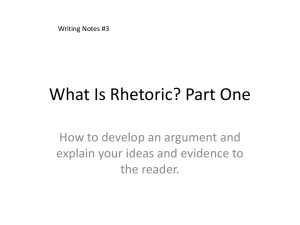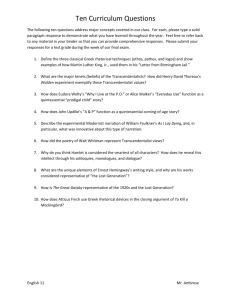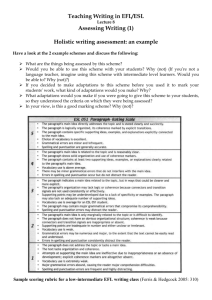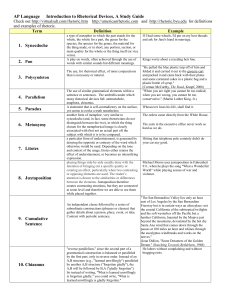Effective Readers, Text Annotation and Rhetoric
advertisement
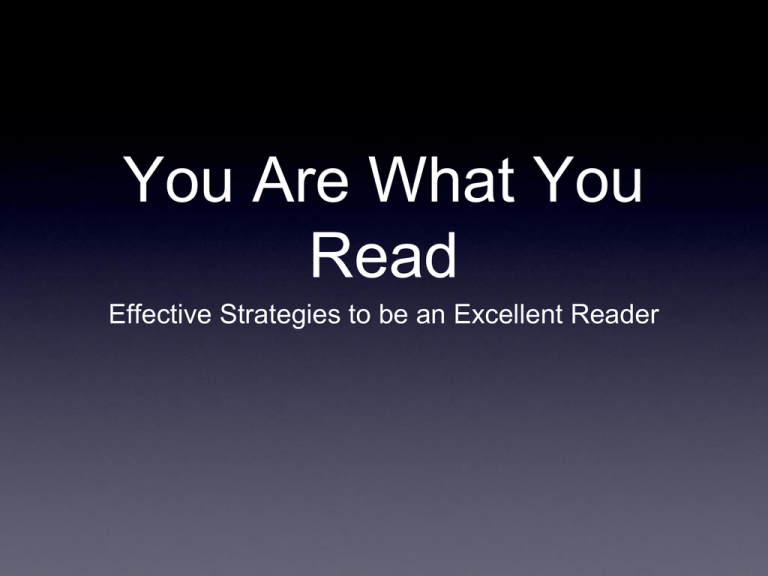
You Are What You Read Effective Strategies to be an Excellent Reader Building Your Reader Experience • Take stock of what you already know • Read everything you like and even things you don’t like • Talk to others about what you read • Read your own writing • Read text at least twice Context • Context: the time period and place that a text was written or created and the situation, the circumstances, surrounding it’s creation and it’s reading. • Before you can understand theme or purpose you must understand context. Text Annotation • • • • Annotating a text means to mark pages with notes. It is an ESSENTIAL strategy to get the most of college level reading. Annotations make it easy to find important information quickly when reviewing a text. Annotations help with familiarizing you with the content and organization of a text. Annotations provides a way to engage with main ideas. Well Annotated Text Will: • clearly identify where important main ideas are located in the text. • express the main ideas • trace development of ideas/arguments throughout the text • introduce reader’s thoughts and reactions Four Ways to Annotate • Highlight/Underline- mark words, phrases or main ideas. These highlighted or underlined ideas help with providing quotes or citations to be used when writing about a text. • Paraphrase/Summarize- while reading make notes in the margins of the main ideas of each paragraph or page. This too will help with writing about the text. Four Ways to Annotate • Comments/Responses- note your own reactions to the text. • Mark in the margins if you agree or disagree with certain ideas. • Question certain arguments, ideas or evidence. • Relate your own personal experience • Make connections between one text and another. Four Ways to Annotate: Descriptive Outline • A descriptive outline will focus on the organization and purpose of a text. • A descriptive outline will identify the following: major arguments or main ideas, examples, facts, counter arguments, transitions and conclusion. Rhetoric: The art of Persuasion • Aristotle defined rhetoric as “the faculty of observing in any given case the available means of persuasion” • Rhetoric can also be defined as “ the way people produce texts to create and communicate meaning.” • Define “Rhetoric” in your own words!!!! Reader’s Rhetorical Triangle • The Reader’s Rhetorical Triangle illustrates the various roles involved in effective communication. This Is How We Do It: Modes of Discourse • There are four major modes or methods of academic writing: Narration, Exposition, Description, and Argumentation/Persuasion • Each mode serves an intended purpose: to describe, to inform, to explain and to persuade • Name examples for each mode and purpose This Is How We Do It: • Rhetorical There are various ways a writer/speaker Strategy will approach and organize a topic: comparison/contrast, exemplification, classification/division, description, definition, narration or process/analysis. • The strategy should be the most effective method to accomplish one’s purpose. • Connect strategies to intended purposes It: Rhetorical Devices • The tools used to convey the message: figurative language, Rhetorical Question, and The Appeals(ethos, logos,pathos) • Ethical Appeal(ethos)- using one’s credibility such as morals/values, religion, title, status or culture to create a good impression • Logical Appeal(logos)- using concrete evidence: facts, statistics and case studies and Rhetorical Question to • Emotional Appeal(pathos)- evoking sympathy from the reader. The most effective ways are loaded words, imagery, anecdotes, examples and figurative language • Which device do you think is the most effective? Why?


![Program`s Dynamic Criteria Map (DCM)[1]](http://s3.studylib.net/store/data/007112770_1-0a2faad44b8e94d6ea99c5f4cbf00e83-300x300.png)


